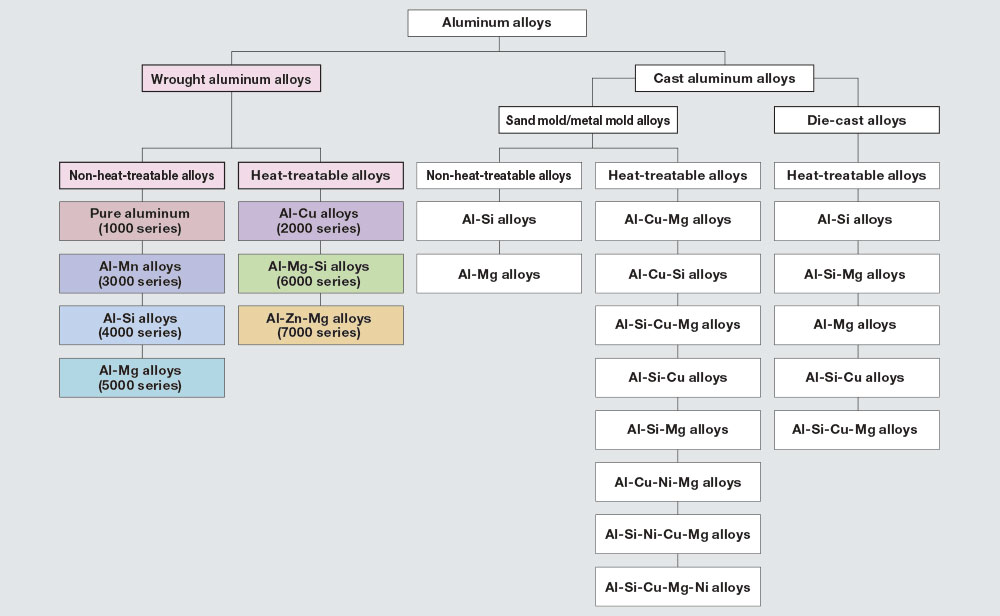Wrought aluminum alloys are classified into a series of alloy systems, indicated by thousand units. They range from the pure aluminum of the 1000 Series to the Al-Zn-Mg alloys of the 7000 Series, according to the type of additive elements, Expanded materials are processed into various shapes, such as sheets and foils by rolling, and shapes, tubes, and rods by extrusion.
Forgings are also included in this category. Aluminum alloys for casting are classified into two systems: those for sand and mold castings and those for die casting. In the system chart shown here, it appears that there are more types of alloys for casting than for drawing, but in fact there are a great many types for drawing.

General properties & applications of aluminum alloys
1000 Series
The 1000 series is an industrial pure aluminum material with an aluminum composition of 99.00% or higher. 1100 and 1200 are typical alloys. The names 1050, 1070, and 1085 indicate that their aluminum purity is 99.50%, 99.70%, and 99.85% or higher pure aluminum respectively. The 1000 series has low material strength, but excellent corrosion resistance, workability, and surface treatment properties. 1060 and 1070 have excellent electrical and thermal conductivity, and they are used for power transmission and distribution equipment and heat-dissipating parts.
Because of the beautiful color tone unique to aluminum obtained through anodic oxidation treatment, they are also used for nameplates and reflective panels.
2000 Series
Al-Cu heat-treated alloys are represented by 2017 and 2024, known respectively as “duralumin” and “super duralumin”. They feature excellent strength and good machinability comparable to steel. However, they are inferior in terms of corrosion resistance, so applications in severely corrosive environments require adequate anti-corrosion treatment.
This series has good machinability, and free-machining alloys such as 2011 are widely used for transportation equipment and machine parts. 2014 is a representative alloy for forging materials, and is used for structural materials as well as vehicle and automobile components due to its high strength and relatively good formability.
3000 Series
The Al-Mn non-heat-treatable alloys 3003 and 3004 are representatives of this series. The addition of Mn increases strength by 10-20% compared to the 1000 Series alloys, and they also have excellent deep drawability. For this reason, they are widely used in the fields of vessels, construction materials, containers, and offset printing plates.
3004 and 3104 are alloys in which about 1% Mg is added equivalent to 3003 to further increase strength. Typical applications include body materials for beverage aluminum cans. In addition, 3003 and 3004 are often used as cladding material for heat exchangers.
4000 Series
4032 and 4043 are typical non-heat-treatable Al-Si alloys. 4032 is an alloy in which the addition of Si suppresses thermal expansion and improves wear resistance, while the addition of Cu, Ni, and Mg improves heat resistance. It’s used in pistons, cylinders, valves, and bearings.
4043 is a typical welding material containing 5% Si. It’s suitable for welding Al-Mg-Si alloys and aluminum castings because of its low melting temperature and high resistance to high-temperature cracking of the metal to be welded. It’s used as welding wire, welding rods, and brazing sheets.
5000 Series
Al-Mg non heat-treatable alloys with Mg content of 0.4% to 5% have excellent corrosion resistance and surface treatability, and therefore have a wide range of uses.
The 5110 alloy with low Mg content is used for decorative materials and vessels, and 5005 for vehicle interiors. The medium-strength 5052 alloy with Mg content of about 2.5% is a general-purpose 5000 Series alloy. And the 5083 alloy with high Mg content is considered a welded structural alloy, featuring the highest strength among non-heat-treatable alloys as well as excellent weldability, seawater resistance, and low temperature properties. It’s used for ship components, vehicle components, low-temperature tanks, pressure vessels, etc.
6000 Series
Al-Mg-Si heat-treatable alloys have excellent strength, corrosion resistance, and surface treatment properties. 6061 and 6063 are representative structural materials. 6061 is a sheet material with a trace amount of Cu added to increase strength, and 6063 is an extruded form material. In particular, 6063 is a representative alloy for aluminum extruded shapes and is used for building sashes, automobile components, and electrical products. Alloys of this series are also increasingly being used for automobile body panels. 6000 series materials have bake-hardening properties that increase strength during the paint baking process, while also improving dent resistance.
7000 Series
The 7000 Series can be classified into the Al-Zn-Mg-Cu alloys, which have the highest strength among aluminum alloys, and the Al-Zn-Mg alloys for welded structures that do not contain Cu, and are used for parts requiring high strength and weight reduction.
7075 is a typical heat-treated Al-Zn-Mg-Cu alloy called super duralumin, and is used as a structural material with lightweight strength.
7204 is a typical heat-treated Al-Zn-Mg alloy for welded structures. It’s used in railroad cars and land structures because of its high strength and excellent joint efficiency, where the heat-affected zone after welding recovers to a strength close to that of the base metal through natural aging.
Guidelines of aluminum alloy choices for automobile components
The 1000 Series is used for heat exchanger parts due to its excellent corrosion resistance and workability; the 3000 Series is used for piping; and the 4000 Series is used for forged parts due to its excellent heat resistance and wear resistance.
The 5000 series is used for various press-formed parts; the 2000 Series is used for parts requiring strength; and the 6000 Series and 7000 Series extruded shapes are used for chassis structural parts and bumper beams.


